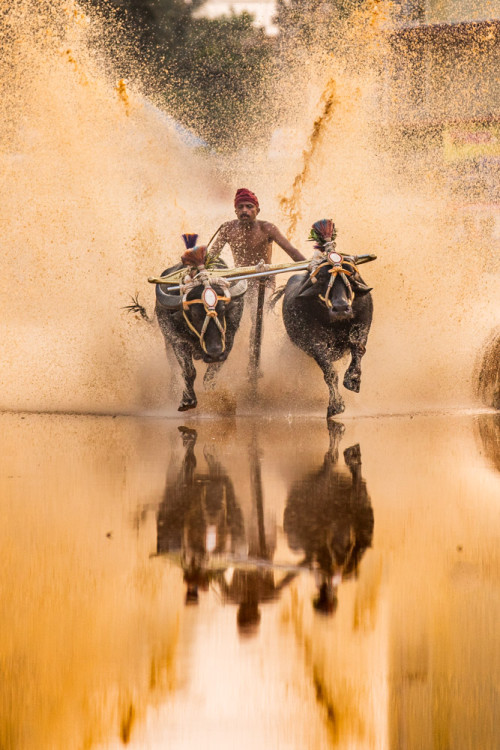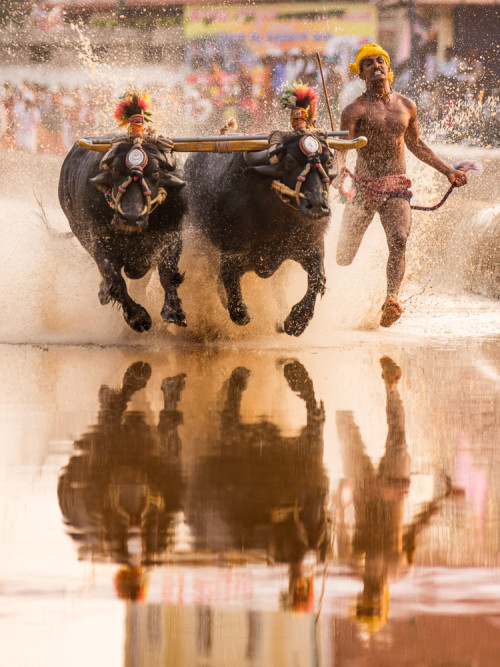
My home town Moodabidri hosted its 14th annual Buffalo race, Kambala at Kadalakere Nisargadhama on Saturday January 23rd. The Kambala or the buffalo race is unique to Udupi & Mangalore districts.

Historically Kambala was the event when farmers paid tribute to their gods for protecting their crops. There used to be lot of celebration and games as part of this festive atmosphere. Some say Kambala also marked the beginning of sowing operations for the second round of crops. Traditionally, there were two types of Kambalas, Pookere Kambala and Bale Kambala. Pookere Kambala is the only variety which survives now.

Kambala is traditionally a simple sport. The Kambala track used for muddy field filled with slush. The contest generally takes place between two pairs of buffaloes, controlled by a racer. Kambala today has become an organized, professional sports. People place massive amounts of bets on the winning buffaloes and one can witness more than 30,000 spectators in a well organized Kambala, egging and cheering the buffaloes to complete the race. As of now, more than 45 races are held annually in Coastal Karnataka. Nearly 18 Kambalas are held under the banner of Kambala Samithi and the rest are held under the auspices of temples, political patronage and aristocratic Bunt households. Kambala still remains a hugely popular sport in Coastal Karnataka.

This large rain water fed track of 145 meters was to witness large number of 173 pairs of Water Buffaloes. On that Saturday huge crowd had gathered to witness this folk sports. I was able to reach the venue only in the evening and for about 2 hours I took the pictures you see here. Nearing Sunset is best time in my opinion for shooting Kambala. Later most of the light will be from the overhead halogen lamps which light up the whole Kambala venue. Every Kambala starts around 9-10 AM and continues non stop, day and night for 24-48 hours depending on the number of buffaloes competing for the race.

I used my Canon EF 70-200mm f/2.8L IS II USM fitted to Canon EOS 5DSR. This one lens & body combo is so perfectly matched for the low light situation and fast action sports. All the photos here are taken at f/2.8, shutter speed mostly above 1/1250th of second to freeze the water droplets. ISO was kept on Auto and varied with light condition. I used AI servo mode using the default Canon EOS 5DSR settings for AI servo which I found works best in a linear race like this. I use AF point expansion with Central point which I can manually focus with assisted 8 surrounding points to help focusing. I did not use central focus point, but chose a point of focus either right or left of the center depending on my composition and angle of approach of the buffalo. Since the Kambala had two tracks (Koti & Chennayaa named after great folk heroes of Tulunadu) this point of focus was changing depending on the direction of shoot.

Kambala races take place in several different categories – Negilu, Hagga, Adda halage and Kene halage are the four broad categories.

Negilu: The runner will hold the plough ( it is not actual plough which is heavy and bulky, it is just a representation of which is tied to pair of buffalo. This type is mostly for the Junior buffaloes or entry level buffaloes. But there is again a junior, senior rounds in this race.

Hagga : A rope is directly tied to the buffalo pair. And this is for Senior buffaloes as the speed is more here and the participating buffaloes are well experienced. This also has a junior, senior levels.

Adda halage : A cross wooden plank is tied to the pair and the runner stands on it while racing. This is just for the senior category.

Kene halage: A round wooden block where the runner stands on it on his single leg. There will be two holes in the block out of which the water forces out while running. The height of the water forcing out is measured to choose the winner. The more the speed is more the water height is. And this is only for senior most category. There are different markers using a white cloth banners. Whichever pair reaches water to these markers is declared a winner. If there are more than one, all those who reached will get prizes

Kene Halage and Adda Halage are 2 forms of the race which has very few contestants participating and is a vanishing from most Kambala races. On this race we had only 2 participants for Kene Halage and 9 for Adda Halage races. All the extreme water splashed photos you see here are from Kene Halage category of race.

There is no fixed rule for size of the track which mostly depends on the availability of the space on the locality. Normally it is between 120 meters to 145 meters long and 8-12 meters wide. There is a thick layer of mud and then water on it. The thumb rule is water is filled in the track so that it completely contains about a feet deep mud. The tracks are called by name so it is easy for communication. In the middle of the track there are two strips of white cloth tied across the track which are used as height measurements for Kene halage races. One gauge is at 5.4 meters which is the highest and the other one is at 4.68 meters.

Kambala is conducted in several parts of two districts Udupi and Mangalore from November to March. It is conducted always on a weekend so that it is possible for most spectators as well as participants all the Kambalas. The race starts usually Saturday morning and goes on all night and finishes Sunday afternoon. The final winners will be rewarded by the officials during the Kambala closing ceremony conducted in Sunday afternoon. It is watched by, on an average 20 to 30,000 spectators in a day.

It is fascinating to know that 145 meter slushy muddy track is covered in just 14 -15 seconds by many of these racers which is very close to the 100 meter world record speeds. They are partially using the speeds of the buffaloes to leverage but still running in such a speed in water is quite an effort. Then there are support teams which take care of buffaloes both at the starting point as well as the finishing line.

Finishing line at the end of the race track (Manjotti)is where all the major excitement of the race takes place. The rider just lets the buffaloes loose as they reach dry ground which is covered in river sand and that is when they may run at the crowd. There are people who control and stop these buffaloes. But if you are in front of it, they may trample on you. My advice is better to be safe than sorry.

It is a hit among the tourists and lot of people from different part of city, country travel to see this race. It is not always all that fun to take photographs of Kambala. If you are not careful you may be gored or trampled by charging Buffaloes. There is a barricade made out out of rope at the edge of the track, do not cross that. No flash photography allowed at all as that startles the buffaloes. Do not let your in built flash to pop out also as the volunteers and team owners will throw you out.

For this GIF file above, I have used 13 sequential captures taken at Focal length of 24 mm at 1/20th second shutter speed, handheld at f/5.6 ISO 100 using Canon EOS 5DSR.


Inspirational captures as always… Thanks for the informative write-up…
Thanks Dr. Krishi for the wonderful information. Photos and GIF is superlative.
Wow…..
Loved the GIF image sequence capture.
Beautiful pictures!! Great write up.
Always saw the talent in you and remember our early days .
Best of luck
Thanks Balnath 🙂 Our College days memory is still wonderful 🙂
VERY GOOD ACTION PHOTOGRAPHY SIR
Great information and awareness about the great traditional event Kambala . I am planing to join Kambla fest during the March , and thanks again for your valuable information . with regards P.Madhusoodanan ,wild life photographer,Thiruvananthapuram ,Kerala.